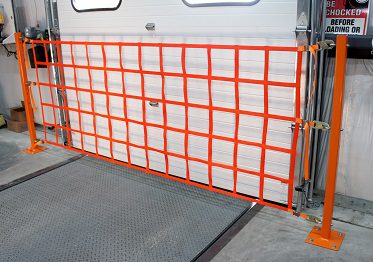Loading Dock Safety
Out of all of the potentially-hazardous areas within a modern distribution or manufacturing facility, loading docks tend to draw the lion’s share of scrutiny, and for good reason. Loading docks are rife with hazards – high-volume freight truck traffic, quickly-moving forklifts, large material loads, obstructed visibility, and exposed ledges, to name a few. In this article, we’d like to share a list of loading dock safety solutions that can help our clients manage hazards, reduce risks, and improve employee welfare. Our solutions are not just the usual list of devices to buy, however – we’re taking a unique approach to convey managerial and operational solutions as well.
Safety Begins with Intent
In our opinion, managing loading dock safety begins with intent. Business owners and managers must subscribe to the concept that safety is a living, breathing animal that must be persistently fed and exercised on behalf of all their staff and visitors.
Passive safety management may take the form of waiting for an accident to occur before safety measures are enforced and is all too common an occurrence given today’s tight budgets, unprecedented shipping volumes, and stretched labor force. Businesses that fall into this pattern usually started out well, producing safety manuals and procedures, installing some safety components, and providing training for supervisors. Over time, however, these businesses fall behind on enforcement, naturally losing sight of their safety standards as training lapses and employees turn over, until eventually, the inevitable accident comes to pass.
Intentional, active management is the alternative safety approach to strive after and needn’t be viewed as too expensive, restrictive, or onerous a practice to adopt. When management actively embodies the intent to prioritize and practice employee safety controls, this broadcasts company-wide awareness that directly translates into fewer accidents, higher productivity, and better margins (thanks to minimizing lost time and workers’ compensation costs).
To help readers travel the path to active loading dock safety management, the remainder of this article will cover three categories of measures that can be implemented at your facility right away. These categories are referred to as ‘controls’ as they serve to mitigate safety hazards by either controlling the existence or exposure of a hazard through deliberate means.
Business Managerial Controls
Business Controls utilize administrative and managerial approaches to parse hazards from loading docks spaces. These controls start with business policies and practices and must be perpetually reinforced by leadership staff.
- Culture: The single best deterrent to preventable accidents may well be that every employee adopts a strong sense of personal responsibility for their safety, as well as that of their coworkers. Furthering this concept, management can demonstrate that it welcomes employees to discuss safety concerns, stop and reconsider before taking risky actions, and speak up when witnessing unsafe activity.
- Workflow Design: Business-as-usual can often trend towards unsafe practices – this is the fault of human nature to repeat risky actions that have not resulted in any adverse situations over long periods of time. Employees cutting across forklift lanes, driving their forklifts over pedestrian lanes, and generally operating in a sense of rush are all examples of workflows that can be managed out to improve safety. Training safety into workflows such as ‘mandatory clean-as-you-go’ or ‘pallets cannot sit in dock space for more than 30 minutes’ helps even more.
- Managerial Attention: As the business management idiom goes, ‘Management can only Expect what it Inspects.’ Speaking about safety is certainly valuable, and documenting safety programs is a requirement in most businesses. But, if management only performs these steps and never revisits or reinforces safety topics again, then the message sent to employees is that of apathy towards these safety requirements. If instead management is tenacious in monitoring, enforcing, and improving safety practices over time (in other words, ‘inspecting’ their safety program consistently), then employees will take away the message that this is a vital requirement to be upkept.
- Communication: Each of the above topics describes a need for frequent and active safety communication, but we’ll add another layer describing the importance of aligning your methods of communication. Safety communication comes in both active and passive forms, both critical to success. Active methods are great, from safety meetings and trainings to institute safety coaching and encouragement. Passive methods are great as well, from signage to easy-to-read safety manuals. Across both forms, business leadership should always ensure that the message they are sending is consistent, accessible to all employees, and never contradicted by actions.
Operational Controls
If we consider the above Business Management Controls to set the route and tone for loading dock (and plant-wide) safety, we can view Operational Controls and the day-in, day-out elements involved in traveling down that route.
- Training: We can have all of the safety policies in the world, but if we do not disseminate that information to our staff thoroughly and repeatedly over time, its value is nil. At its root, training serves to familiarize staff with concepts that are not common or intuitive knowledge. When performed in live settings and with high levels of engagement, we can imprint muscle memory and preferred reactions into the staff in ways that a PowerPoint presentation cannot. Include skill assessments and feedback loops between employees to lock in this new knowledge.
- Documented Procedures: Training employees as described above comes hand-in-hand with the need to standardize and store the details of such training for ongoing reference, new hire training, and regulatory compliance. Employees should have free access to safety documentation at any time. This documentation should be as clear as possible for employees to gain the entirety of the procedure or process without another party having to add clarification (think: lots of photos, instructional graphics, and/or videos). In the event that an accident occurs, this documentation will also be critical in proving the business’ compliance and understanding of regulated, safe practices. If unsure where to start, begin by web-searching ‘Injury and Illness Prevention Program’ (IIPP), ‘Business Safety Plan,’ and ‘Workplace Hazard Assessment’ templates.
- Inspection: We covered the ethos of managerial inspections above, and now we’ll turn that into tangible operational actions. Every employee group, on every shift, every day, should be exposed to at least one form of in-situ inspection. While there is no hard-and-fast rule for how to perform safety inspections, we prefer the following approach:
- Supervisors perform pre-shift safety walks
- All employees are required to self-check themselves and their areas against large example posters on walls (IE, a picture of the loading dock free of pallets and floor debris to serve as a visual guide)
- Certified job positions complete their daily inspections and document their results (such as forklift operators performing their forklift walk-around)
- Maintenance / Engineering staff perform weekly (or as-needed) inspections checking safety devices, lighting, powered fork trucks, and all other systems
- Safety staff perform both routine and random inspections to include in-place coaching, retraining, and skills reinforcement
- Teamwork: The safest employee groups are trained as functional team units, with the belief that each individual is responsible for the safety of their colleagues, without question. Employees should be instilled with the expectation that they are to ask for help, work together, and wait for assistance before ever performing a risky action. Specific team-centric skills should be considered expected job duties, such as spotting a forklift entering a trailer, multiple sets of eyes on trailer clamp connections, and hand-signaling for loud spaces.
Engineering Controls
Managerial and Operational approaches to loading dock safety are paramount in providing employees with the safest possible working environment, but there will always be the need for tactile safety systems, as we’ll discuss next. These Engineering Controls can be considered fixed, technical, and resilient safety devices installed within and around the loading dock.
- Facility Infrastructure: Providing a safe loading dock begins with its design and is partly maintained by the building infrastructure that supports the space. Proper lighting, ventilation, temperature control, floor drainage (and de-icing if applicable), dock levelers and baffles, traffic mirrors, truck driver signal beacons, dockboards, ramps, and forklifts themselves are all equipment provisions that contribute to safe operations. Maintenance of these systems is very important, whether it’s performed in-house or by third parties specializing in maintaining each system.
- Fall Protection: Open loading dock doors and ramp sides are two fall hazards that unfortunately lead to far too many accidents annually due to improper (or absent) safety protection. Safety chains, barrier bars, and netting guards are ideal solutions for exposed dock fall hazards. In particular, InCord’s Loading Dock Nets are reinforced fabric WebNets™ installed between steel posts and serve as physical fall protection for employees and materials inadvertently nearing an open dock door. These loading dock nets are also custom-designed to fit specific size requirements.
- Structural Barriers: Different from fall protection restraints, substantial structural barricades are called for to serve personnel and equipment protection purposes in loading dock spaces. Traffic guard rails can be installed along foot traffic paths, fully able to withstand the impact of a forklift traveling at average speeds. Steel bollards, rails, and frames are also used to protect material racking, dock openings, door openings, and fixed equipment (such as electrical panels) from forklift impact. Tire stops and guides can even be installed outside in the truck bays to help control trailer alignment and building hits.
- Traffic Demarcation: If fall protection serves to keep operators from walking off an open dock end, and structural barriers withstand the impact of a rogue vehicle, then this last topic of Traffic Demarcation serves as the in-between solution by visually and physically creating distinct, separate spaces for employees and vehicle traffic. Painted floor markings for walking paths, forklift lanes, truck bays, and material staging locations communicate the proper locations for different employee activities. In addition, differentiation provides guidance to staff on which areas they may conduct their work within, promoting loading dock safety by segregating hazardous traffic. But, while visual guidance helps train and guide normal dock activities, it is not a physical deterrent, so we still need the aforementioned fall protection and structural barriers to provide physical protection in abnormal activities and/or an impending accident.
About InCord
InCord manufactures custom safety netting solutions and lifting and rigging products for a range of industries. Our woman-owned Colchester, CT manufacturing plant is an ISO-9001 certified facility, housing a team ready to design and fabricate a unique netting solution to fit your needs. InCord was founded in 1995 and is a Connecticut Top Workplace. To discuss an application, request a quote, or obtain technical guidance, please call us at (860) 537-1414, submit a request here, or email us at netting@incord.com.






